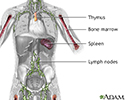Secondary infections
A secondary infection is an infection that occurs during or after treatment for another infection. It may be caused by the first treatment or by changes in the body or immune system that allow a second infection.
Two examples of a secondary infection are:
- A vaginal yeast infection after taking antibiotics to treat an infection caused by bacteria
- Pneumonia caused by bacteria or fungi after having an upper respiratory infection (like a cold) that was caused by a virus
References
Clifton IJ, Ellames DAB. Respiratory medicine. In: Penman ID, Ralston SH, Strachan MWJ, Hobson RP, eds. Davidson's Principles and Practice of Medicine. 24th ed. Philadelphia, PA: Elsevier; 2023:chap 17.
Dockrell DH, Sundar S, Angus BJ. Infectious disease. In: Penman ID, Ralston SH, Strachan MWJ, Hobson RP, eds. Davidson's Principles and Practice of Medicine. 24th ed. Philadelphia, PA: Elsevier; 2023:chap 13.
-
Secondary infection - illustration
Secondary infection occurs during or after treatment of a primary infection because the normal bacterial flora is destroyed, allowing yeast to flourish.
Secondary infection
illustration
-
Immune system structures - illustration
The immune system protects the body from potentially harmful substances. The inflammatory response (inflammation) is part of innate immunity. It occurs when tissues are injured by bacteria, trauma, toxins, heat or any other cause.
Immune system structures
illustration
-
Secondary infection - illustration
Secondary infection occurs during or after treatment of a primary infection because the normal bacterial flora is destroyed, allowing yeast to flourish.
Secondary infection
illustration
-
Immune system structures - illustration
The immune system protects the body from potentially harmful substances. The inflammatory response (inflammation) is part of innate immunity. It occurs when tissues are injured by bacteria, trauma, toxins, heat or any other cause.
Immune system structures
illustration
Review Date: 8/26/2023
Reviewed By: Jatin M. Vyas, MD, PhD, Roy and Diana Vagelos Professor in Medicine, Columbia University Vagelos College of Physicians and Surgeons, Division of Infectious Diseases, Department of Medicine, New York, NY. Also reviewed by David C. Dugdale, MD, Medical Director, Brenda Conaway, Editorial Director, and the A.D.A.M. Editorial team.



